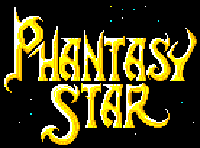
 |
|
Note: Given the importance of the storyline sequences in the Phantasy Star series, heavy spoilers are contained in our comprehensive retrospective. RPG franchises were a rare commodity in the 80s. The U.S. had Ultima and Dungeons & Dragons, while Enix's Dragon Quest had already established itself in Japan and Square's Final Fantasy would soon follow suit. Another series of equal importance was emerging, though, as the groundbreaking Phantasy Star was released in Japan during 1987 and the following year in the U.S. for the 8-bit Sega Master System. Despite falling victim to little publicity and modest sales figures, Phantasy Star remains one of the most revolutionary RPGs ever released. Even Sega's recent opus, Skies of Arcadia, was announced as the game "developed by the Phantasy Star team."
Rather than the usual medieval castles, knights and dragons, Phantasy Star differentiated itself with a backdrop of three planets in a hybrid age. This was a far cry from the setting found in virtually every other RPG to date. But while high-tech in nature, Phantasy Star still did manage to incorporate dragons, Medusa, and even a floating castle in the sky. Undoubtedly, Phantasy Star's most impressive feature is the continuing storyline, as characters and settings resurface throughout the entire series. Players are introduced to the Algol Solar System, comprised of three planets revolving around a sun: Motavia, the desert planet, Palma, the green planet, and Dezoris, the ice planet. This setting would be the game's and the entire series' centerpiece. The plot itself was complex and intriguing, especially by the standards of the day. Algol's King Lassic, once a virtuous ruler, turns to a tyrannical dark side. A rebel group is formed to oppose him led by the brave fighter, Nero. The game begins hauntingly as Lassic's Robotcops guard kills Nero. As he dies, he gives a dying message to his sister, Alis -- to find Odin, a fighter with legendary strength, in order to stop Lassic. The wheels are set in motion for a grand adventure as you play in the role of Alis. Next to join the troupe roster is the animal sidekick, Myau, and the Esper wizard, Noah.
Particularly noteworthy is the choice of protagonist in the game. When Final Fantasy and Dragon Quest had clichéd knights, Phantasy Star's feminine hero set the game apart in yet another way. Each character also had a backstory and purpose; the cast simply didn't meander the world with the sole intention of saving the princess or defeating a given antagonist. Another departure was from the super-deformed style, as Phantasy Star used tall, human-like characters. While the sci-fi narrative amounts to basically good versus evil, the plot was presented in a much more sophisticated way than its peers. As gamers could probably now appreciate, the entirety of the story and a full understanding its concepts had to be obtained via full exploration. In a welcome nod to story aficionados, the series' storylines are all interconnected and have holes left intentionally and unintentionally, meaning that those who play the sequels will realize even more about the plot.
Once Lassic falls to Alis' mythical sword, the group of four travel back to the governor's mansion on Motavia for a celebratory congregation. Unexpectedly, Dark Force, who would become the series' recurring villain, reveals itself then. The game's ending would make known other story details about Alis and Nero's heritage, and later on the sequels would further expand their roles as well as Dark Force's. Exploring the Algol solar system was no problem for Alis' motley crew, whether treacherously on foot or with help from a collection of vehicles that included a landrover, hovercraft, icedigger, and spaceship. Though towns and overworlds were in typical overhead view, the brilliantly designed 3D dungeons are where Phantasy Star's graphical prowess shone. The game impressively uses software-based scaling and rotation to render movement in dungeons. It would remain a high watermark until more powerful systems hit the scene, such as the SNES' Mode 7 and Sega's own RPG Shining Force for the Genesis.
Battles in dungeons occur on the same screen in which you travel, while overworld battles take you to a battle screen with an appropriate terrain setting. Like the rest of the Phantasy Star series, turn-based battles are presented in a 3D-type perspective. The game adds to magic and attack options with a talk feature that allows the troupe to talk to monsters for information. Another impressive feature are the character and monster designs and their animations. Each monster is illustrated in great detail and every individual attack and magic has its own unique animation. Fishman's tongue striking out at enemies was a large step ahead of Dragon Warrior's screen flashing. If the game has any flaws, they would undoubtedly be in level building and dungeon size. Not only are 3D dungeons far less navigable than overhead ones, but each had multitudes of levels, trapdoors and floors that could set you back. This could be frustrating, though the game overall was no more difficult or level-heavy than other games of the time. Unfortunately, Phantasy Star received little recognition in the US despite being released before Dragon Warrior and Final Fantasy. But even today, the title still deserves the highest of accolades for combining innovation in many areas with one of the best videogame storylines ever conceived. Phantasy Star was truly a landmark game in genre history and one no RPG experience can be complete without having played. Retrospective by Jeff Davis, GIA. |
|
|||||||||||||||||||||||||||||||||||||||||||||||




